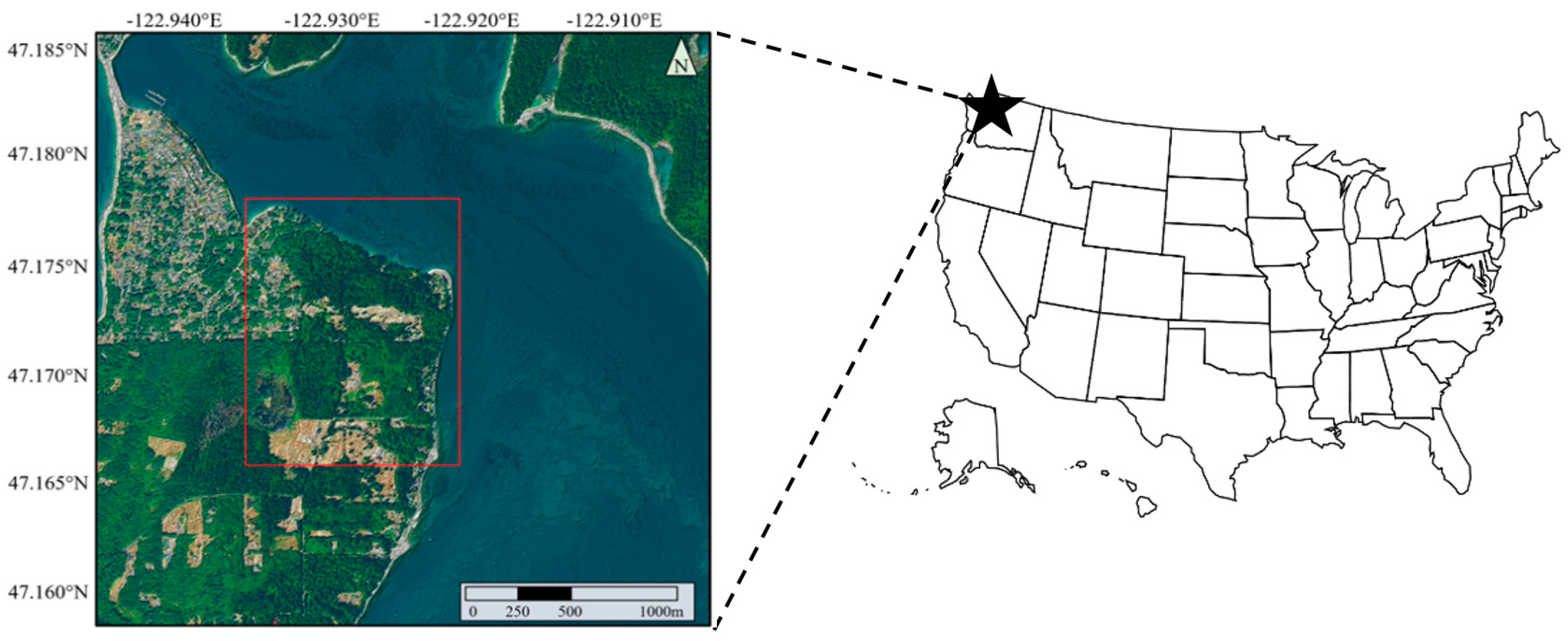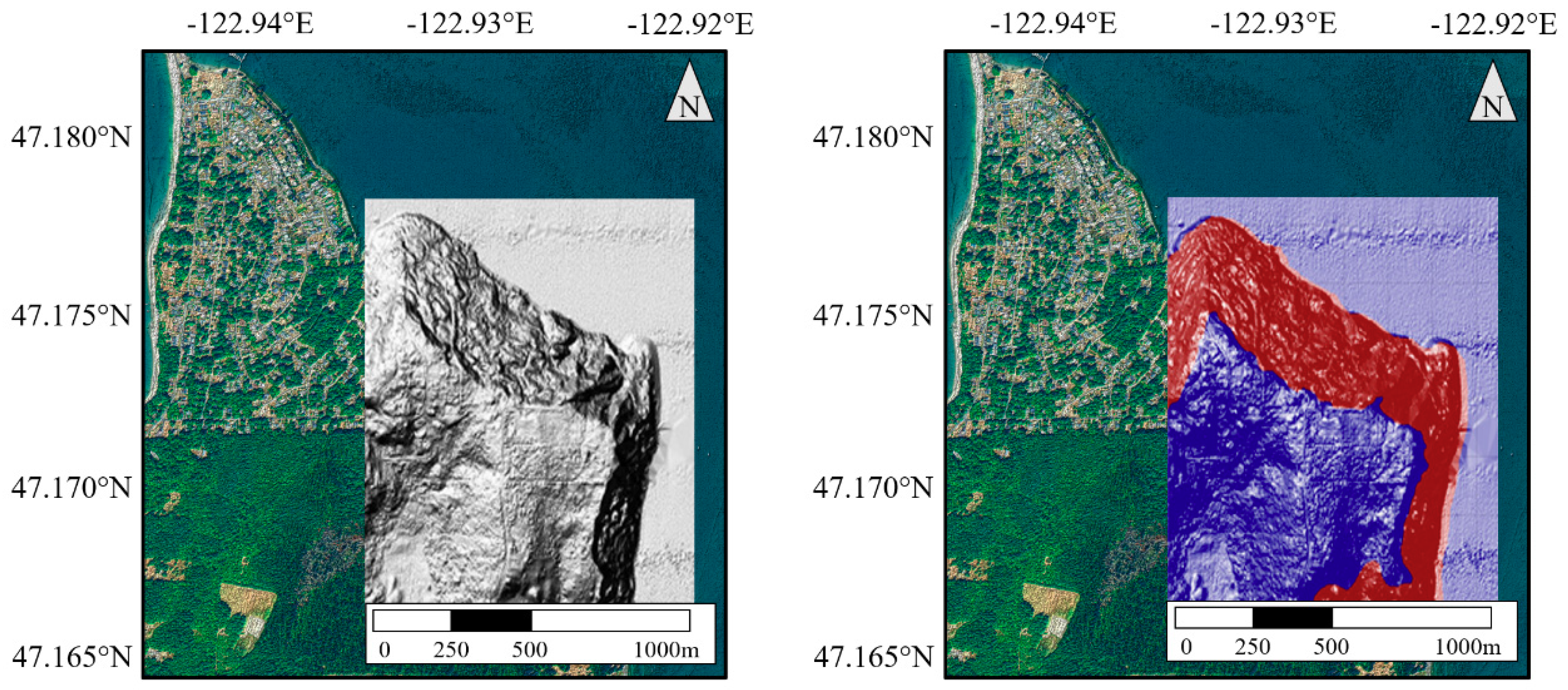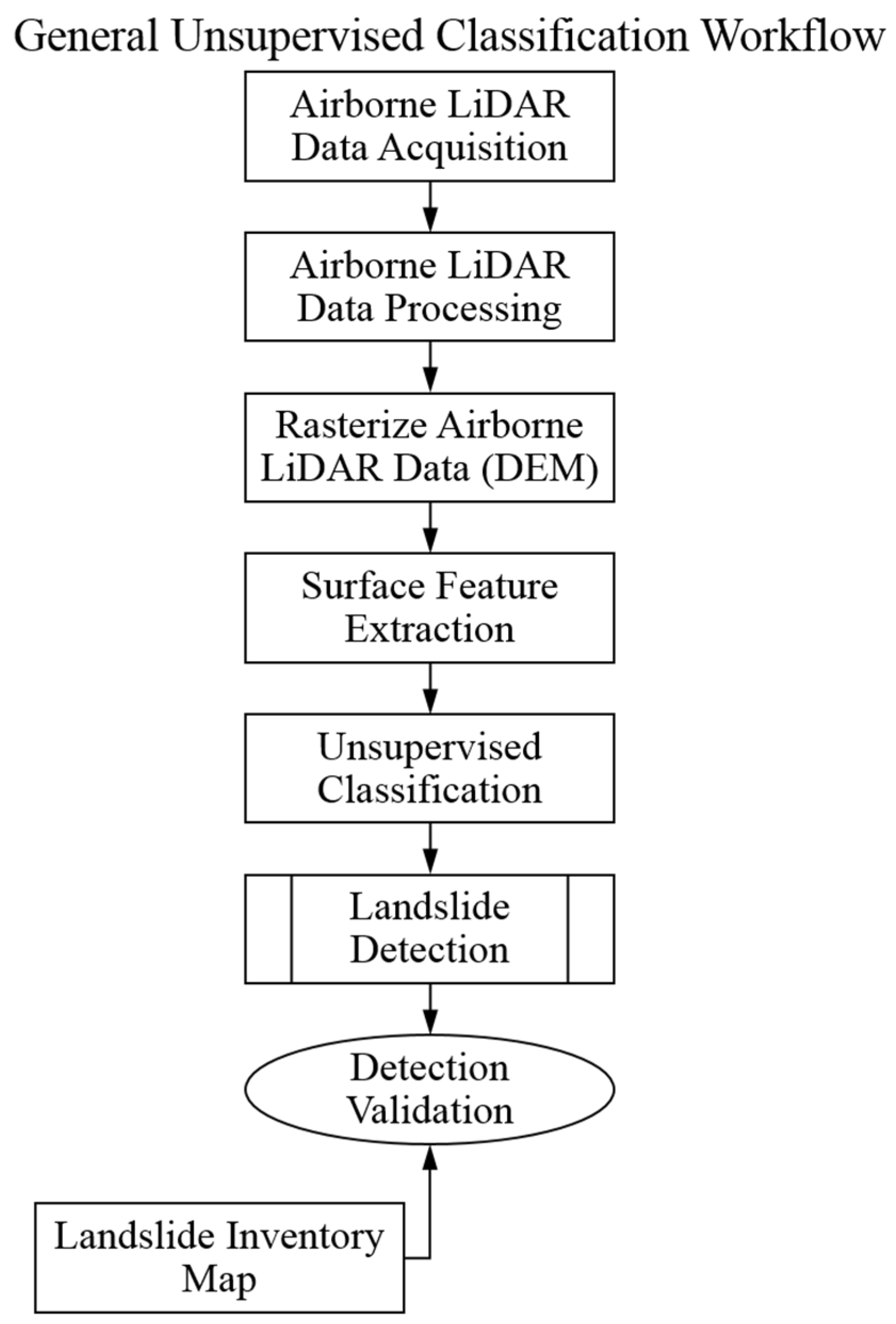Unsupervised Classification for Landslide Detection from Airborne Laser Scanning
Abstract
1. Introduction
2. Study Area, Light Detection and Ranging (LiDAR) Data and Inventory Map
3. Methodology
3.1. Algorithm
3.2. Landslide Surface Feature Extraction
3.2.1. Roughness
Z01 Z11 Z21
Z00 Z10 Z20
3.2.2. Slope
3.2.3. Local Topographic Range
3.2.4. Local Topographic Variability
3.3. Clustering Methods
3.4. Accuracy Assessment
4. Results and Discussion
5. Conclusion
Author Contributions
Funding
Acknowledgments
Conflicts of Interest
References
- Ahmed, B.; Rahman, M.; Islam, R.; Sammonds, P.; Zhou, C.; Uddin, K.; Al-Hussaini, T. Developing a dynamic Web-GIS based landslide early warning system for the Chittagong Metropolitan Area Bangladesh. ISPRS Int. J. Geo-Inf. 2018, 7, 485. [Google Scholar] [CrossRef]
- Lu, P.; Stumpf, A.; Kerle, N.; Casagli, N. Object-oriented change detection for landslide rapid mapping. IEEE Geosci. Remote S. 2011, 8, 701–705. [Google Scholar] [CrossRef]
- Song, Y.; Niu, R.; Xu, S.; Ye, R.; Peng, L.; Guo, T.; Li, S.; Chen, T. Landslide susceptibility mapping based on weighted gradient boosting decision tree in Wanzhou section of the Three Gorges Reservoir Area (China). ISPRS Int. J. Geo-Inf. 2019, 8, 4. [Google Scholar] [CrossRef]
- Effat, H.A.; Hegazy, M.N. Mapping landslide susceptibility using satellite data and spatial multicriteria evaluation: The case of Helwan District, Cairo. Appl. Geomatics 2014, 6, 215–228. [Google Scholar] [CrossRef]
- Dalyot, S.; Keinan, E.; Doytsher, Y. Landslide morphology analysis model based on LiDAR and topographic dataset comparison. Surv. Land Inf. Sci. 2008, 68, 155–170. [Google Scholar]
- McKean, J.; Roering, J. Objective landslide detection and surface morphology mapping using high-resolution airborne laser altimetry. Geomorphology 2004, 57, 331–351. [Google Scholar] [CrossRef]
- Mora, O.E.; Liu, J.K.; Lenzano, M.G.; Toth, C.K.; Grejner-Brzezinska, D.A. Small landslide susceptibility and hazard assessment based on airborne lidar data. Photogramm. Eng. Rem. S 2015, 81, 239–247. [Google Scholar] [CrossRef]
- Mora, O.E.; Liu, J.K.; Lenzano, M.G.; Toth, C.K.; Grejner-Brzezinska, D.A.; Fayne, J.V. Landslide Change Detection Based on Multi-Temporal Airborne LiDAR-Derived DEMs. Geosciences 2018, 8, 23. [Google Scholar] [CrossRef]
- Reichenbach, P.; Rossi, M.; Malamud, B.; Mihir, M.; Guzzetti, F. A review of statistically-based landslide susceptibility models. Earth Sci. Rev. 2018, 180, 60–91. [Google Scholar] [CrossRef]
- Booth, A.M.; Roering, J.J.; Perron, J.T. Automated landslide mapping using spectral analysis and high-resolution topographic data: Puget Sound lowlands, Washington, and Portland Hills, Oregon. Geomorphology 2009, 109, 132–147. [Google Scholar] [CrossRef]
- Glenn, N.F.; Streutker, D.R.; Chadwick, D.J.; Thackray, G.D.; Dorsch, S.J. Analysis of LiDAR-derived topographic information for characterizing and differentiating landslide morphology and activity. Geomorphology 2006, 73, 131–148. [Google Scholar] [CrossRef]
- Mora, O.E.; Lenzano, M.C.; Toth, C.K.; Grejner-Brzezinska, D.A. Analyzing the Effects of Spatial Resolution for Small Landslide Susceptibility and Hazard Mapping. 2014. Available online: https://www.int-arch-photogramm-remote-sens-spatial-inf-sci.net/XL-1/293/2014/isprsarchives-XL-1-293-2014.pdf (accessed on 13 April 2019).
- Mezaal, M.R.; Pradhan, B. An improved algorithm for identifying shallow and deep-seated landslides in dense tropical forest from airborne laser scanning data. CATENA 2018, 167, 147–159. [Google Scholar] [CrossRef]
- Pawluszek, K.; Borkowski, A.; Tarolli, P. Sensitivity analysis of automatic landslide mapping: Numerical experiments towards the best solution. Landslides 2018, 15, 1–15. [Google Scholar] [CrossRef]
- Si, A.; Zhang, J.; Tong, S.; Lai, Q.; Wang, R.; Li, N.; Bao, Y. Regional Landslide Identification Based on Susceptibility Analysis and Change Detection. ISPRS Int. J. Geo-Inf. 2018, 7, 394. [Google Scholar] [CrossRef]
- Sun, X.; Chen, J.; Bao, Y.; Han, X.; Zhan, J.; Peng, W. Landslide Susceptibility Mapping Using Logistic Regression Analysis along the Jinsha River and Its Tributaries Close to Derong and Deqin County, Southwestern China. ISPRS Int. J. Geo-Inf. 2018, 7, 438. [Google Scholar] [CrossRef]
- Borkowski, A.; Perski, Z.; Wojciechowski, T.; Jozkow, G.; Wojeik, A. Landslides Mapping in Roznow Lake Vicinity, Poland Using Airborne Laser Scanning Data. Available online: https://www.irsm.cas.cz/materialy/acta_content/2011_03/14_Borkowski.pdf (accessed on 13 April 2019).
- Shrestha, S.; Kang, T.S.; Suwal, M.K. An Ensemble Model for Co-Seismic Landslide Susceptibility Using GIS and Random Forest Method. ISPRS Int. J. Geo-Inf. 2017, 6, 365. [Google Scholar] [CrossRef]
- Bardarella, M.; Di Benedetto, A.; Finai, M.; Guida, D.; Lugli, A. Use of DEMs Derived from TLS and HRSI Data for Landslide Feature Recognition. ISPRS Int. J. Geo-Inf. 2018, 7, 160. [Google Scholar] [CrossRef]
- Fayne, J.V.; Ahamed, A.; Roberts-Pierel, J.; Rumsey, A.C.; Kirschbaum, D. Automated Satellite-Based Landslide Identification Product for Nepal. Earth Interact. 2019, 23, 1–21. [Google Scholar] [CrossRef]
- Pawluszek, K.; Borkowski, A. Impact of DEM-derived factors and analytical hierarchy process on landslide susceptibility mapping in the region of Rożnów Lake, Poland. Nat. Hazards 2017, 86, 919–952. [Google Scholar] [CrossRef]
- Tarolli, P.; Sofia, G.; Dalla Fontana, G. Geomorphic features extraction from high-resolution topography: Landslide crowns and bank erosion. Nat. Hazards 2012, 61, 65–83. [Google Scholar] [CrossRef]
- Bardi, F.; Raspini, F.; Ciampalini, A.; Kristensen, L.; Rouyet, L.; Lauknes, T.; Frauendelder, R.; Casagli, N. Space-borne and ground-based InSAR data integration: The Åknes test site. Remote Sens. 2016, 8, 237. [Google Scholar] [CrossRef]
- Shan, J.; Toth, C.K. Topographic Laser Ranging and Scanning: Principles and Processing; CRC Press: Boca Raton, FL, USA, 2018. [Google Scholar]
- Jaboyedoff, M.; Oppikofer, T.; Abellán, A.; Derron, M.H.; Loye, A.; Metzger, R.; Pedrazzini, A. Use of LIDAR in landslide investigations: A review. Nat. Hazards 2012, 61, 5–28. [Google Scholar] [CrossRef]
- An, H.; Kim, M.; Lee, L. Survey of spatial and temporal landslide prediction methods and techniques. Korean J. Agric. Sci. 2016, 43, 507–521. [Google Scholar]
- Leshcinsky, B.A.; Olsen, M.J.; Tanyu, B.F. Contour Connection Method for automated identification and classification of landslide deposits. Comput. Geosci. 2015, 74, 27–38. [Google Scholar] [CrossRef]
- Cheng, G.; Guo, L.; Zhao, T.; Han, J.; Li, H.; Fang, J. Automatic landslide detection from remote-sensing imagery using a scene classification method based on BoVW and pLSA. Int. J. Remote Sens. 2013, 34, 45–59. [Google Scholar] [CrossRef]
- Hölbling, D.; Friedl, B.; Eisank, C. An object-based approach for semi-automated landslide change detection and attribution of changes to landslide classes in northern Taiwan. Earth Sci. Inform. 2015, 8, 327–335. [Google Scholar] [CrossRef]
- Dou, J.; Bui, D.T.; Yunus, A.P.; Jia, K.; Song, X.; Revhaug, I.; Xia, H.; Zhu, Z. Optimization of causative factors for landslide susceptibility evaluation using remote sensing and GIS data in parts of Niigata, Japan. PLoS ONE 2015, 10, 133262. [Google Scholar] [CrossRef] [PubMed]
- Sarkar, S.; Kanungo, D.P.; Patra, A.K.; Kumar, P. GIS based spatial data analysis for landslide susceptibility mapping. J. Mt. Sci. 2008, 5, 52–62. [Google Scholar] [CrossRef]
- Seber, G.A. Multivariate Observations; John Wiley & Sons: Hoboken, NJ, USA, 2004; Volume 252, pp. 347–394. [Google Scholar]
- Banfield, J.D.; Raftery, A.E. Model-Based Gaussian and Non-Gaussian Clustering. Available online: https://apps.dtic.mil/dtic/tr/fulltext/u2/a222097.pdf (accessed on 13 April 2019).
- Gorsevski, P.V.; Gessler, P.E.; Jankowski, P. Integrating a fuzzy k-means classification and a Bayesian approach for spatial prediction of landslide hazard. J. Geogr. Syst. 2003, 5, 223–251. [Google Scholar] [CrossRef]
- Gorsevski, P.V.; Jankowski, P.; Gessler, P.E. Spatial Prediction of Landslide Hazard Using Fuzzy k-means and Dempster-Shafer Theory. Trans. GIS 2005, 9, 455–474. [Google Scholar] [CrossRef]
- Borghuis, A.M.; Chang, K.; Lee, H. Comparison between automated and manual mapping of typhoon-triggered landslides from SPOT-5 imagery. Int. J. Remote Sens. 2007, 28, 1843–1856. [Google Scholar] [CrossRef]
- Melchiorre, C.; Matteucci, M.; Azzoni, A.; Zanchi, A. Artificial neural networks and cluster analysis in landslide susceptibility zonation. Geomorphology 2008, 94, 379–400. [Google Scholar] [CrossRef]
- Naidu, S.; Sajinkumar, K.S.; Oommen, T.; Anuja, V.J.; Samuel, R.A.; Muraleedharan, C. Early warning system for shallow landslides using rainfall threshold and slope stability analysis. Geosci. Front. 2018, 9, 1871–1882. [Google Scholar] [CrossRef]
- Slaughter, S.L.; Burns, W.J.; Mickelson, K.A.; Jacobacci, K.E.; Biel, A.; Contreras, T.A. Protocol for landslide inventory mapping from lidar data in Washington State. Wash. Geol. Surv. Bull. 2017, 82, 27. [Google Scholar]
- Burns, W.J.; Madin, I.A. Protocol for Inventory Mapping of Landslide Deposits from Light Detection and Ranging (LiDAR) Imagery; Oregon Department of Geology: Oregon, OR, USA, 2009; p. 23. [Google Scholar]
- GeoEngineers. Report, Phase I-Reconnaissance Evaluation, Carlyon Beach/Hunter Beach Landslide; Thurston County: Washington, DC, USA, 1999. [Google Scholar]
- GeoEngineers. Report, Phase II-Reconnaissance Evaluation, Carlyon Beach/Hunter Beach Landslide; Thurston County: Washington, DC, USA, 1999. [Google Scholar]
- Lee, J.; Fisher, P.F.; Snyder, P.K. Modeling the effect of data errors on feature extraction from digital elevation models. Photogramm. Eng. Rem. S. 1992, 58, 1461–1467. [Google Scholar]
- Martha, T.R.; Kerle, N.; Van Westen, C.J.; Jetten, V.; Kumar, K.V. Segment optimization and data-driven thresholding for knowledge-based landslide detection by object-based image analysis. IEEE T. Geosci. Remote 2011, 49, 4928–4943. [Google Scholar] [CrossRef]
- Bilmes, J. A Gentle Tutorial of the EM Algorithm and its Application to Parameter Estimation for Gaussian Mixture and Hidden Markov Models. Available online: http://www.leap.ee.iisc.ac.in/sriram/teaching/MLSP_18/refs/GMM_Bilmes.pdf (accessed on 13 April 2019).
- McLachlan, G.; Peel, D. Finite Mixture Models; John Wiley & Sons, Inc.: New York, NY, USA, 2000; pp. 238–256. [Google Scholar]
- Lewis, H.G.; Brown, M. A generalized confusion matrix for assessing area estimates from remotely sensed data. Int. J. Remote Sens. 2001, 22, 3223–3235. [Google Scholar] [CrossRef]
- Schuldt, C.; Laptev, I.; Caputo, B. Recognizing human actions: A local SVM approach. In Proceedings of the 17th International Conference, Cambridge, UK, 26 August 2004. [Google Scholar]
- Visa, S.; Ramsay, B.; Ralescu, A.L.; Van Der Knaap, E. Confusion Matrix-based Feature Selection. MAICS 2011, 710, 120–127. [Google Scholar]





| Feature | NO. Clusters | Accuracy (%) | True Positive (%) | False Positive (%) | True Negative (%) | False Negative (%) | Precision (%) |
|---|---|---|---|---|---|---|---|
| Roughness | 2 | 83.70 | 95.35 | 25.34 | 74.66 | 4.65 | 74.48 |
| 3 | 82.82 | 95.58 | 27.08 | 72.92 | 4.42 | 73.25 | |
| 4 | 86.84 | 91.86 | 17.06 | 82.94 | 8.14 | 80.68 | |
| 5 | 86.92 | 91.43 | 16.58 | 83.42 | 8.57 | 81.05 | |
| Slope | 2 | 43.69 | 100.0 | 100.0 | 00.00 | 00.00 | 43.69 |
| 3 | 84.36 | 81.75 | 13.61 | 86.39 | 18.25 | 82.33 | |
| 4 | 85.63 | 90.98 | 18.53 | 81.47 | 9.02 | 79.21 | |
| 5 | 85.81 | 88.69 | 16.42 | 83.58 | 11.31 | 80.73 | |
| Local Topographic Range | 2 | 82.82 | 95.79 | 27.23 | 72.77 | 4.21 | 73.18 |
| 3 | 85.63 | 94.30 | 21.09 | 78.91 | 5.70 | 77.62 | |
| 4 | 86.30 | 93.27 | 19.11 | 80.89 | 6.73 | 79.11 | |
| 5 | 86.50 | 92.69 | 18.30 | 81.70 | 7.31 | 79.71 | |
| Local Topographic Variability | 2 | 43.69 | 100.0 | 100.0 | 00.00 | 00.00 | 43.69 |
| 3 | 78.79 | 90.49 | 30.28 | 69.72 | 9.51 | 69.86 | |
| 4 | 84.89 | 77.15 | 9.11 | 88.31 | 22.85 | 86.79 | |
| 5 | 84.71 | 80.06 | 11.69 | 87.56 | 19.94 | 84.16 |
| Feature | NO. Clusters | Accuracy (%) | True Positive (%) | False Positive (%) | True Negative (%) | False Negative (%) | Precision (%) |
|---|---|---|---|---|---|---|---|
| Roughness | 2 | 87.19 | 87.91 | 13.37 | 86.62 | 12.09 | 83.60 |
| 3 | 86.28 | 93.70 | 19.47 | 80.53 | 6.30 | 78.87 | |
| 4 | 87.09 | 86.81 | 12.69 | 87.31 | 13.19 | 84.14 | |
| 5 | 86.98 | 91.16 | 16.26 | 83.74 | 8.84 | 81.30 | |
| Slope | 2 | 54.54 | 99.42 | 80.27 | 19.73 | 0.58 | 49.00 |
| 3 | 83.80 | 79.98 | 13.24 | 86.76 | 20.02 | 82.41 | |
| 4 | 85.45 | 91.55 | 19.28 | 80.72 | 8.45 | 78.65 | |
| 5 | 85.47 | 86.05 | 14.94 | 85.06 | 13.95 | 81.72 | |
| Local Topographic Range | 2 | 87.20 | 87.96 | 13.37 | 86.61 | 12.04 | 83.59 |
| 3 | 86.00 | 93.89 | 20.13 | 79.87 | 6.11 | 78.35 | |
| 4 | 87.22 | 88.22 | 13.55 | 76.45 | 11.78 | 83.47 | |
| 5 | 86.70 | 91.92 | 19.36 | 82.64 | 8.08 | 80.43 | |
| Local Topographic Variability | 2 | 84.12 | 81.07 | 13.51 | 86.49 | 18.93 | 82.31 |
| 3 | 72.27 | 96.29 | 46.38 | 53.62 | 3.42 | 61.69 | |
| 4 | 84.02 | 73.63 | 7.92 | 92.08 | 26.38 | 87.83 | |
| 5 | 85.03 | 78.93 | 10.24 | 89.76 | 21.07 | 85.68 |
© 2019 by the authors. Licensee MDPI, Basel, Switzerland. This article is an open access article distributed under the terms and conditions of the Creative Commons Attribution (CC BY) license (http://creativecommons.org/licenses/by/4.0/).
Share and Cite
Tran, C.J.; Mora, O.E.; Fayne, J.V.; Lenzano, M.G. Unsupervised Classification for Landslide Detection from Airborne Laser Scanning. Geosciences 2019, 9, 221. https://doi.org/10.3390/geosciences9050221
Tran CJ, Mora OE, Fayne JV, Lenzano MG. Unsupervised Classification for Landslide Detection from Airborne Laser Scanning. Geosciences. 2019; 9(5):221. https://doi.org/10.3390/geosciences9050221
Chicago/Turabian StyleTran, Caitlin J., Omar E. Mora, Jessica V. Fayne, and M. Gabriela Lenzano. 2019. "Unsupervised Classification for Landslide Detection from Airborne Laser Scanning" Geosciences 9, no. 5: 221. https://doi.org/10.3390/geosciences9050221
APA StyleTran, C. J., Mora, O. E., Fayne, J. V., & Lenzano, M. G. (2019). Unsupervised Classification for Landslide Detection from Airborne Laser Scanning. Geosciences, 9(5), 221. https://doi.org/10.3390/geosciences9050221






